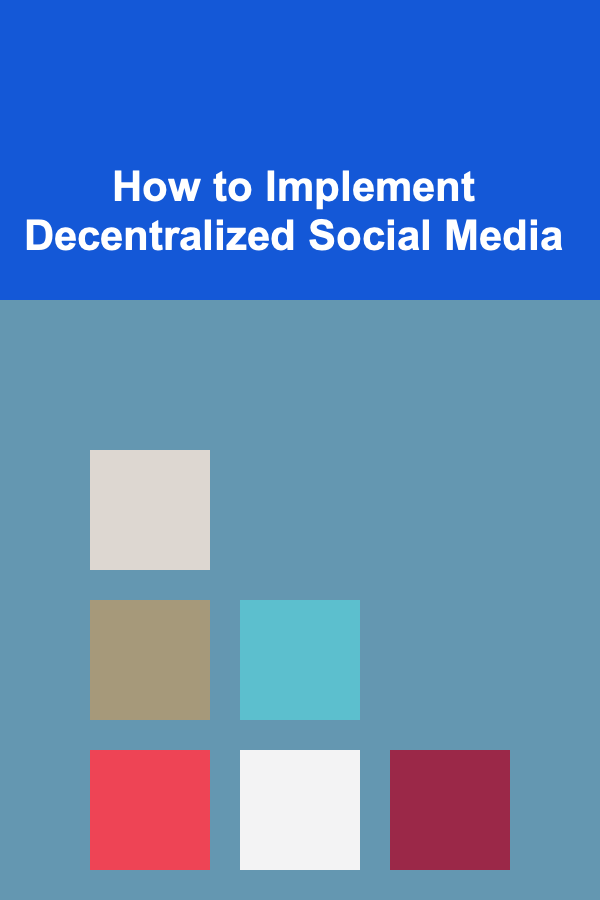
How to Implement Decentralized Social Media
ebook include PDF & Audio bundle (Micro Guide)
$12.99$10.99
Limited Time Offer! Order within the next:

The internet has dramatically reshaped the way people interact with each other, and one of the most influential phenomena has been social media. From Facebook and Twitter to Instagram and TikTok, social media platforms have become central to the daily lives of millions of people around the world. However, despite their ubiquity and usefulness, many of these platforms are controlled by centralized entities, raising concerns about privacy, censorship, data exploitation, and the manipulation of public opinion.
In response to these concerns, the idea of decentralized social media has gained traction. Decentralized social media platforms aim to give users greater control over their data, reduce the risk of censorship, and foster a more democratic, open, and user-centric internet. But how exactly can decentralized social media be implemented? What are the challenges and benefits? This article explores the concept of decentralized social media, examining how it can be implemented, the technological foundation required, and the potential societal impacts.
What is Decentralized Social Media?
Decentralized social media is a type of platform where control, governance, and infrastructure are not concentrated in the hands of a single organization or entity. Instead, the platform operates on a distributed network where users have more control over their data and interactions. In a decentralized social media system, no central authority exists that can make decisions about content moderation, user data, or the algorithmic distribution of posts.
Key features of decentralized social media include:
- User control: Users own and control their data, and they can choose who has access to it.
- No central authority: Governance is distributed, often using blockchain or peer-to-peer networks.
- Privacy: Enhanced privacy features, as users can control who sees their content and how it is used.
- Resilience: Decentralized networks are less vulnerable to censorship and can continue to function even if one part of the network goes down.
In contrast to traditional social media platforms, where user data is owned and controlled by companies like Facebook or Twitter, decentralized social media empowers users by distributing control across a wider network.
The Benefits of Decentralized Social Media
1. Privacy and Data Ownership
One of the most significant benefits of decentralized social media is the control it gives users over their data. In traditional centralized systems, platforms collect vast amounts of personal data about their users, which is often monetized through targeted advertising. This raises serious privacy concerns, especially as data can be misused, sold, or hacked.
In a decentralized system, users own their data, and they can decide what data they share and with whom. The transparency provided by decentralized networks means that users have more insight into how their data is used, making it harder for companies to exploit their information for profit.
2. Freedom from Censorship
Centralized social media platforms are often accused of censoring content, whether for political reasons, advertiser interests, or to comply with government regulations. In some countries, social media censorship is a tool used to suppress dissent or unpopular opinions. This has raised concerns about the role of private companies in determining what content is allowed and who gets to participate in public discourse.
Decentralized social media removes the single point of control that enables censorship. Content moderation and governance are typically distributed, with decisions made by the community or through algorithmic processes that are transparent and open for scrutiny. This makes it more difficult for any one entity to suppress speech, allowing for a more open and democratic exchange of ideas.
3. Enhanced Security and Resilience
Centralized platforms are vulnerable to hacks, data breaches, and outages. When a platform like Facebook or Twitter is compromised, millions of users' personal information can be exposed. Furthermore, these platforms can be taken down or shut off entirely, either by the company itself or by government authorities.
Decentralized platforms, however, are typically more secure and resilient. Since there is no central server storing all the data, it is harder for attackers to target a single point of failure. Additionally, the decentralized nature of these networks makes them more robust to government takedowns or technical failures.
4. Reduced Risk of Manipulation
Centralized platforms often use proprietary algorithms to determine what content users see in their feeds. These algorithms are typically designed to maximize engagement, often by prioritizing sensational or controversial content. This can lead to echo chambers, the spread of misinformation, and the manipulation of public opinion.
In decentralized social media systems, users have more control over the content they see. Instead of being subjected to the whims of an opaque algorithm, users can curate their own feeds based on their interests and preferences. This reduces the risk of manipulation and creates a more personalized, transparent user experience.
The Challenges of Implementing Decentralized Social Media
While the potential benefits of decentralized social media are significant, there are also several challenges that must be addressed to make it a reality.
1. Scalability
Scalability is one of the biggest challenges facing decentralized networks. Traditional social media platforms like Facebook and Twitter are able to scale easily due to their centralized nature. They rely on powerful data centers that can handle millions of concurrent users, store vast amounts of data, and ensure fast and responsive service.
In a decentralized network, however, there is no central infrastructure to manage this load. Instead, the responsibility for maintaining the network falls on a distributed set of nodes or users. Each participant in the network may need to contribute resources (such as computing power, storage, or bandwidth), and ensuring the network can handle millions of users without performance degradation is a significant technical challenge.
2. Content Moderation
Content moderation is another complex issue in decentralized social media. In a traditional platform, content is often moderated by a team of employees who enforce rules and guidelines. However, in a decentralized system, it is more difficult to maintain a consistent and fair moderation policy.
Without a central authority, there is a risk that harmful content---such as hate speech, misinformation, or illegal material---could proliferate. While decentralized platforms may use community-based moderation or algorithmic systems, ensuring that these methods are effective and fair is a major challenge. A decentralized network must strike a balance between freedom of expression and protecting users from harmful content.
3. User Experience
For decentralized social media platforms to succeed, they must offer an intuitive, user-friendly experience. Centralized platforms have spent years optimizing their interfaces and creating seamless experiences for users. In contrast, many decentralized platforms are still in their infancy and may lack the polish and ease-of-use that users expect.
To compete with established platforms, decentralized networks will need to invest in improving the user experience, ensuring that it is as easy to use as Facebook or Instagram, while also maintaining the principles of decentralization.
4. Interoperability
Interoperability refers to the ability of different systems to communicate and work together. In a decentralized social media landscape, there will likely be many different platforms and networks, each with its own governance, protocols, and user interfaces. For the ecosystem to thrive, these platforms must be able to communicate with one another.
Currently, decentralized platforms operate in silos, which means that users on one platform cannot easily interact with users on another. This fragmentation limits the reach and effectiveness of decentralized social media. Solutions like open protocols and standards (e.g., ActivityPub, the protocol used by Mastodon) are being developed to address this issue, but widespread adoption is still a work in progress.
5. Adoption and Network Effects
Finally, one of the most significant challenges in implementing decentralized social media is achieving mass adoption. Centralized platforms like Facebook and Twitter have billions of active users, creating a powerful network effect that makes it difficult for new entrants to compete. For decentralized social media platforms to be successful, they must overcome this barrier and attract large numbers of users.
The adoption of decentralized platforms will require strong incentives, such as enhanced privacy, freedom of expression, and control over data, but it will also require widespread education and outreach to convince users to make the switch. Without a critical mass of users, decentralized platforms will struggle to gain traction and compete with the dominance of established centralized platforms.
Technological Foundations of Decentralized Social Media
To implement decentralized social media, several core technologies are required. These technologies enable the distributed, transparent, and secure nature of decentralized networks, and they form the backbone of most decentralized applications (dApps).
1. Blockchain Technology
Blockchain is a distributed ledger technology that enables secure, transparent, and tamper-proof transactions. It is most commonly associated with cryptocurrencies like Bitcoin, but its applications extend far beyond digital currencies. Blockchain can be used to create decentralized systems where data is stored in blocks and linked together in a chain, ensuring that no single party has control over the data.
In decentralized social media, blockchain can be used for various purposes, including:
- Content ownership: Users can prove ownership of their content through digital signatures and blockchain-based timestamps.
- Governance: Blockchain-based voting mechanisms can be used to make decisions about platform governance and content moderation.
- Tokenization: Social media platforms can issue tokens to reward users for content creation or other contributions.
2. Peer-to-Peer Networks
Peer-to-peer (P2P) networks are decentralized networks where participants share resources directly with one another, without relying on central servers. This is the underlying architecture of many decentralized applications, including social media platforms.
In P2P-based social media, users can share content, interact with each other, and participate in governance without needing a central authority. Popular P2P technologies include:
- IPFS (InterPlanetary File System): A distributed file storage system that allows users to share and access content without relying on a centralized server.
- WebRTC (Web Real-Time Communication): A protocol that enables real-time communication between peers in a decentralized manner, often used for video calls and messaging.
3. Cryptography
Cryptography plays a crucial role in ensuring the security and privacy of decentralized social media platforms. Strong encryption protocols are used to protect user data, secure communications, and verify identity. End-to-end encryption ensures that only the sender and recipient of a message can read its contents, preventing third parties from intercepting or tampering with messages.
4. Federated Systems
Federation refers to the ability of multiple independent servers to work together as part of a larger system. In a federated social media system, different servers (called instances) operate independently but can communicate and share content with one another. For example, Mastodon, a decentralized Twitter alternative, is a federated platform where users can join different instances, but still interact with users across other instances.
Federation enables a level of decentralization while maintaining interoperability between different platforms, allowing users to enjoy the benefits of decentralization without sacrificing network effects.
Conclusion
Implementing decentralized social media is no small feat, but the potential benefits make it an area worth exploring. By giving users control over their data, protecting against censorship, enhancing privacy, and promoting a more open and democratic internet, decentralized social media has the potential to revolutionize the way people interact online.
However, significant challenges remain, including issues of scalability, content moderation, user experience, interoperability, and mass adoption. To overcome these challenges, decentralized platforms will need to leverage innovative technologies like blockchain, peer-to-peer networks, and cryptography. Additionally, the success of decentralized social media depends on a vibrant community of users and developers who are committed to building a better, more equitable internet.
As decentralized technologies continue to evolve, it is likely that decentralized social media will become more feasible, more popular, and more secure. With time, these platforms could reshape the digital landscape, empowering users and reducing the dominance of centralized tech giants.

10 Simple Strategies for Saving Money on Groceries Every Week
Read More
How to Make Pet-Friendly DIY Projects for Your Home
Read More
Smart Strategies for Saving on Prescription Medications Every Time
Read More
How to Understand the Role of Live Sound Engineers
Read More
How to Track Debt Payoff for Couples: A Shared Approach
Read More
How to Measure the ROI of Corporate Communications Initiatives
Read MoreOther Products

10 Simple Strategies for Saving Money on Groceries Every Week
Read More
How to Make Pet-Friendly DIY Projects for Your Home
Read More
Smart Strategies for Saving on Prescription Medications Every Time
Read More
How to Understand the Role of Live Sound Engineers
Read More
How to Track Debt Payoff for Couples: A Shared Approach
Read More